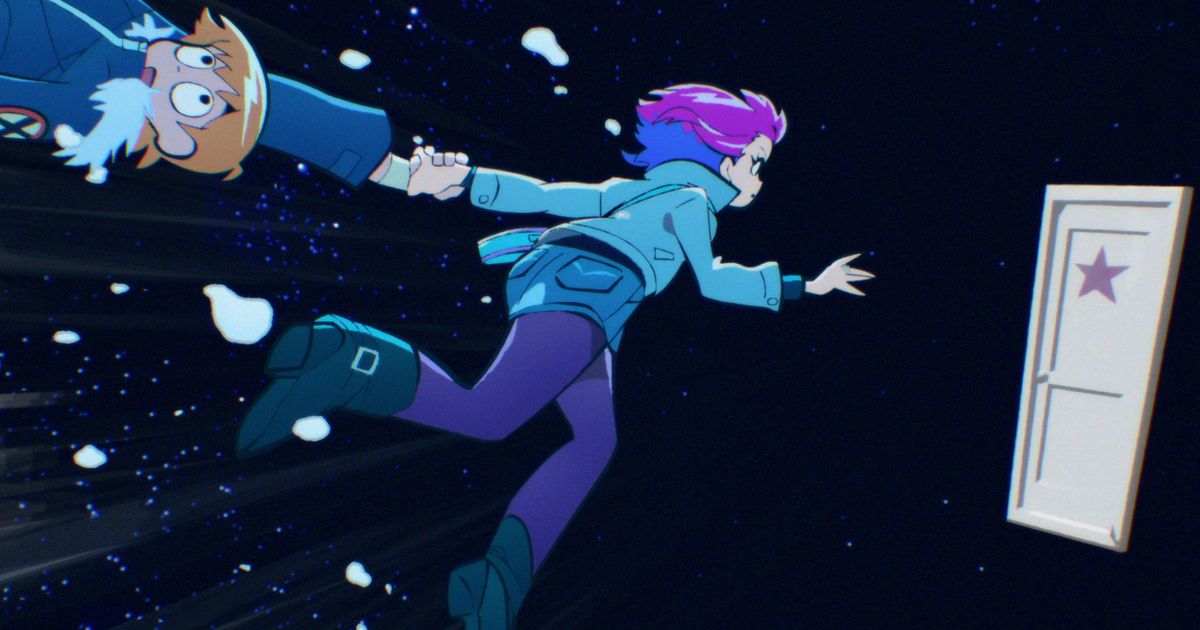Scott Pilgrim Takes Off hinges on a major twist, so if you’re interested in going into the series cold, just take this with you: It’s very good.
Photo: Netflix
Scott Pilgrim has always existed in a strange little pocket of time, one that seems perpetually on the brink of techno-modernity, and this continues to be true in its latest incarnation. In the new Netflix anime series Scott Pilgrim Takes Off, out today, the world has spun on and the cultural references have been updated, but computers are still loud, blocky, charming things. Grimy music venues and video rental spaces remain present in Scott’s Toronto, though you do feel a greater sense of their precarity. The future is encroaching from over the horizon, but Scott Pilgrim still doesn’t care. After all, he’s still dating a high-schooler when he meets the girl of his dreams.
Published by Oni Press across the 2000s, the Scott Pilgrim graphic novels bottled a vibrant feeling of being young and wayward in that cuspy Gen-X era. Written and illustrated by Bryan Lee O’Malley (with later rereleases inked by colorist Nathan Fairbairn), the books followed the journey of a sweet but self-centered 20-something dirtbag who falls in love with the effortlessly cool Ramona Flowers and ends up having to fight her seven evil exes. Along the way, he learns to see beyond himself, or at least in that general direction. The stickiness of Scott Pilgrim has a lot to do with how it captures the mess of being in your 20s, but its je ne sais quoi lies in the texture of its setting, a mundane Toronto that’s cut with literalizations of video game and manga references. Despite possessing the lanky frame of an indie bassist, Scott happens to be a great fighter who’s constantly getting into scuffles straight out of Dragon Ball. Defeated antagonists explode into a mist of video game coins. Ramona is a rollerblading courier who uses Scott’s subconscious as an extradimensional superhighway to cut down on delivery times.
Broadly popular during its run, the Scott Pilgrim book series ended up being adapted multiple times in one giant swoop. Most prominent was the visually extravagant Edgar Wright film featuring Michael Cera and Mary Elizabeth Winstead as Scott and Ramona, plus an absurdly stacked supporting cast that included Chris Evans, Kieran Culkin, Aubrey Plaza, Anna Kendrick, and Brie Larson. In a nod to the books’ inspirations, an astonishingly solid side-scrolling action game was released alongside the film, and there was also an animated Adult Swim TV special adapting just one section of the books. All three came out in 2010, and each tackled the same story with streamlining adjustments befitting their respective medium. As a collective, they produced a fascinating effect, like experiencing different minor frequencies of the same fictional life.
This new anime series, though, operates on a whole new wavelength. It finds O’Malley returning to Scott Pilgrim after more than a decade, this time in collaboration with the writer-director BenDavid Grabinski (Happily) and the critically acclaimed Japanese animation studio Science SARU (Devilman: Crybaby, Inu-Oh, Star Wars: Visions). It also, miraculously, features the return of the movie’s entire cast, but it’s worth noting here that Scott Pilgrim Takes Off isn’t the redux it first seems to be. This adaptation hinges on a major twist that’s worth being fastidious about, so if you’re interested in going into the series cold, just take this with you: It’s very good.
But let’s say you’ve decided to stick around this review. What you should know is that the anime turns on a sleight of hand. The first episode mostly takes the form of a beat-by-beat re-creation of the original story, albeit with subtle differences. Scott comes with softer edges, for example: Where he’s introduced in the books as almost boastful about dating the much younger Knives Chau, on whom he’ll cheat when he later meets Ramona, the Scott in Takes Off comes off more reticent, even conflicted. (Also, Ramona is now a courier for Netflix, not Amazon, natch.) Takes Off only reveals its true gambit at the end of that first episode, which takes us through to Scott’s confrontation with Matthew Patel (Satya Bhabha), the first of Ramona’s evil exes. Instead of Scott winning the fight, the altercation ends with our hero getting pummeled into a handful of coins; much of the next episode takes place at his funeral. But again, nothing is as it seems. Ramona comes to suspect that something weirder is afoot and spends the rest of the season trying to figure out what’s actually going on, a quest that leads her to grapple with her seven evil exes and her past all on her own.
Once he takes off, Scott stays gone for the most part, and into the void steps everyone else. Now free from being defined purely in relation to Scott’s journey of self-actualization, Ramona and the rest of the ensemble — her evil exes, but also Scott’s bandmates, his put-upon high-schooler girlfriend Knives (Ellen Wong), his roommate Wallace Wells (Culkin) — are given arcs of their own. By the end, they all get to become fuller, richer characters within the framework of the Scott Pilgrim universe and its original story.
Did I mention the whole thing looks gorgeous? Scott Pilgrim takes to the anime form well. Science SARU sticks close to the original design of O’Malley’s books, but overlays the aesthetic with a cozier, dreamy feel that effortlessly darts between extravagant action sequences and quieter, more meditative scenes. The latter is key to the anime’s reason for being; through its pacing and visuals, it unlocks a lovely, appealing feeling of contentment. Nowhere does this come across more than in a wonderful scene from the third episode, where Knives and Kim (Alison Pill), left alone in a room, strike up an impromptu jam session. “How do I know which notes to play?” Knives asks, having just picked up a bass guitar for the first time. “It’s up to you,” Kim replies. “That’s why they call it ‘play.’” The space, a cold living room bathed in sunlight, melts into abstraction as Knives bobs to her own bassline. (The original songs by Anamanaguchi, who also did the music for the video game, are superb.) Stars emerge, the universe ripples, a giant heart forms.
Scott Pilgrim is fundamentally an artifact of love. Of the pop culture and places that shaped its creators, from video games to manga to movies to Toronto to the indie music that gives its titular hero his name. Of the highs and lows of figuring out who you’re supposed to become. But there’s also a kind of aggression to the original books — Scott has a goal, and we’re all just barreling towards it. O’Malley wrote them in his twenties, and there’s a discernible angst between the zaniness: over having to become an adult, over authenticity and art, over the weight of all your past mistakes. Part of what’s striking about Takes Off is how that angst no longer feels present. The sense of love that created Scott Pilgrim seems to have been redirected inwards, with O’Malley and Grabinski refracting an affection for these characters that has only deepened with the passage of time. In true Scott Pilgrim fashion, this perspective of age gets literalized in Takes Off, especially in the last two episodes of the season.
It’s interesting to think about Takes Off as an “adaptation,” because the word doesn’t feel precise enough to characterize what it actually is: a continued conversation. I’m fairly certain the anime works as a standalone piece that introduces Scott Pilgrim to a new generation of audiences, but its grand design can only truly be realized by audiences who have lived with the original story — along with the many discussions sprung from it — for the past decade. In this, Scott Pilgrim Takes Off fits nicely with a spate of recent works that operate on a similarly ambitious self-reflexive level: HBO’s Watchmen, functionally a sequel to Alan Moore’s legendary graphic novels; Final Fantasy VII Remake, simultaneously a modernization, expansion, and subversion of the classic 1997 video game; and perhaps most overtly, the Rebuild of Evangelion film series, which similarly to Takes Off begins as a direct recreation of the highly influential ’90s-era Neon Genesis Evangelion anime series before diverging sharply into its own identity. All three works bank on a history of shared experience before subverting expectations and breaking away to do something new. All three are also conscious meditations on the legacy of their original texts.
Befitting Scott Pilgrim’s already strong predilection toward the meta, there’s an elegance to the anime’s self-reflexive adaptation. It’s nothing so simple as a work that’s trying to “fix” problems with the source material. Rather, O’Malley and Grabinski approach Takes Off as a natural extension of how we grow up out of the muck of early adulthood and settle into what comes next. The season resolves in a manner that feels true to the original story, with its characters accepting their pasts and embracing the future. But something feels different now. The future hinted at in Takes Off comes off more ambiguous, uncertain, challenging. But now our characters are able to face that future in stride, bobbing their heads to a bassline they’re just playing around with, content to mellow out and simply be here.

Sophie Anderson, a UK-based writer, is your guide to the latest trends, viral sensations, and internet phenomena. With a finger on the pulse of digital culture, she explores what’s trending across social media and pop culture, keeping readers in the know about the latest online sensations.








